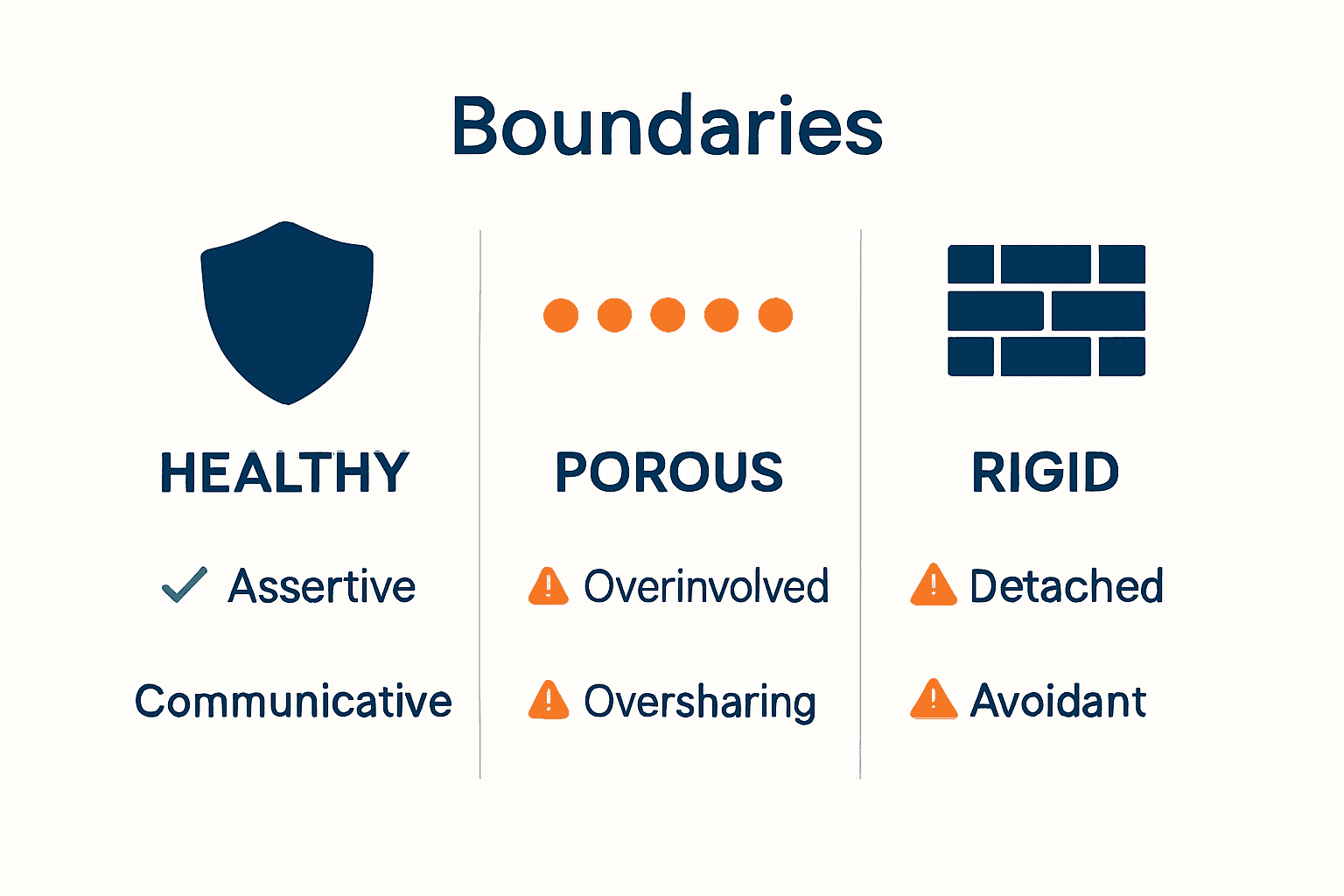Healthy Boundaries in Relationships Explained Fully
Almost everyone has faced a moment when saying ‘no’ felt nearly impossible. Healthy boundaries are critical for relationships that nurture respect and personal well-being, yet a study found over 60 percent of adults struggle to set clear limits with others. Understanding how to define your boundaries not only strengthens your most important connections but also protects your emotional health. Here you will find clear guidance and practical steps for building relationships that honor both your needs and those of others.
Table of Contents
- Defining Healthy Boundaries in Relationships
- Types of Relationship Boundaries Explained
- Key Signs of Healthy Versus Unhealthy Boundaries
- Practical Strategies for Setting Boundaries
- Risks and Consequences of Poor Boundaries
Key Takeaways
| Point | Details |
|---|---|
| Importance of Healthy Boundaries | Healthy boundaries protect personal autonomy and emotional well-being while fostering respectful relationships. They are about communicating limits, not controlling others. |
| Types of Boundaries | Understand physical, emotional, and time boundaries to maintain balanced interactions and prevent misunderstandings. Tailoring boundaries to personal comfort is essential. |
| Signs of Healthy vs Unhealthy Boundaries | Healthy boundaries exhibit self-respect and clear communication, while unhealthy boundaries can lead to emotional exhaustion and unbalanced relationships. Recognize and develop flexible boundaries. |
| Boundary Setting Strategies | Practice self-reflection to identify limits, communicate them clearly using assertive language, and consistently enforce boundaries for lasting emotional health. |
Defining Healthy Boundaries in Relationships
Healthy boundaries are the foundation of strong, respectful relationships where individuals can maintain their sense of self while connecting authentically with others. According to Cleveland Clinic, boundaries involve recognizing and respecting your own personal needs and emotional limits within relationships.
At their core, healthy boundaries represent a framework of understanding between people that protects individual emotional space and personal autonomy. They are not about creating walls or distance, but establishing clear guidelines that communicate self-respect and mutual understanding. These boundaries can manifest in various forms – from communicating when you need personal space to declining social invitations that might overwhelm you, to expressing your comfort levels in intimate interactions.
Key Characteristics of Healthy Boundaries
Healthy boundaries typically include several critical elements:
- Clear communication about personal limits and expectations
- Consistent enforcement of stated boundaries
- Respect for both your own and others’ emotional needs
- Flexibility that allows for growth and adaptation
- Assertive yet compassionate language
When individuals successfully implement boundaries, they create relationship dynamics that feel safe, predictable, and nurturing. For deeper insights into managing relationship dynamics, explore our guide on boundaries in relationships.
Ultimately, setting healthy boundaries is not about controlling others, but about taking responsibility for your own emotional well-being. It requires self-awareness, courage, and a commitment to treating yourself and your relationships with genuine respect.
Types of Relationship Boundaries Explained
Relationships are complex ecosystems of personal interactions, and understanding the various types of boundaries is crucial for maintaining healthy connections. According to Utah State University Extension, there are three primary types of boundaries: physical, emotional, and time boundaries, each playing a unique role in interpersonal dynamics.
Core Types of Relationship Boundaries
Physical Boundaries involve personal space, touch preferences, and physical comfort levels. These boundaries determine how and when physical contact is acceptable, ranging from handshakes to intimate touches. They’re about respecting individual comfort zones and understanding personal physical limits.
Emotional Boundaries focus on managing and protecting one’s emotional energy. As Pikes Peak State College explains, these boundaries exist on a spectrum from porous to rigid, with healthy boundaries representing a balanced approach. They involve:
- Recognizing and communicating your feelings
- Not taking responsibility for others’ emotions
- Protecting yourself from emotional manipulation
- Maintaining emotional self-care
Time Boundaries relate to how individuals allocate and protect their personal time. This includes setting limits on work commitments, social interactions, and personal space. Effective time boundaries help prevent burnout and ensure a balanced lifestyle.

For individuals seeking deeper understanding of relationship dynamics, our guide on boundaries in relationships offers comprehensive insights into navigating these complex interpersonal landscapes.
Additional boundary types include intellectual boundaries (respecting different opinions), sexual boundaries (consent and comfort levels), and material boundaries (sharing resources and personal possessions). The key is finding a personalized approach that feels authentic and comfortable for you.
Key Signs of Healthy Versus Unhealthy Boundaries
Understanding the difference between healthy and unhealthy boundaries is crucial for maintaining positive relationships and personal well-being. According to University of California, Berkeley, boundaries can be categorized as healthy, porous, or rigid, each with distinct characteristics that profoundly impact interpersonal dynamics.
Characteristics of Healthy Boundaries
Healthy boundaries demonstrate a balanced approach to personal interactions. They involve:
- Valuing and expressing your own opinions confidently
- Sharing personal information appropriately and selectively
- Respecting others’ right to say ‘no’ without taking it personally
- Maintaining clear and consistent communication
- Feeling comfortable asserting your needs without guilt
In contrast, unhealthy boundaries often manifest through two extreme patterns. Porous boundaries might look like:
- Oversharing personal information
- Constantly seeking validation from others
- Difficulty saying ‘no’ to requests
- Taking responsibility for others’ emotions
- Compromising personal values to please others
Rigid boundaries, on the other hand, represent the opposite extreme and include:
- Complete emotional withdrawal
- Avoiding intimate or close relationships
As University of Edinburgh suggests, the ideal approach involves flexible boundaries that allow individuals to selectively decide what to let in and what to keep out.

To gain deeper insights into managing emotional dynamics, check out our guide on healthy versus unhealthy anger, which complements understanding boundary management.
Recognizing and developing healthy boundaries is a skill that requires self-awareness, practice, and compassion. It’s about creating a balanced approach that protects your emotional well-being while remaining open to meaningful connections.
Practical Strategies for Setting Boundaries
Setting healthy boundaries requires intentional practice and self-awareness. According to Cleveland Clinic, effective boundary setting involves identifying personal limits, communicating them clearly, and maintaining consistency in their enforcement.
Step-by-Step Boundary Setting Approach
Self-Reflection Techniques:
- Identify Your Limits
- Recognize what makes you uncomfortable
- Understand your emotional triggers
- Assess which interactions drain your energy
- Communicate Clearly
- Use direct, respectful language
- Express your needs without apologizing
- Practice phrases like “I feel… when…”
Practical Communication Strategies:
- Be specific about your boundaries
- Use “I” statements
- Avoid over-explaining or becoming defensive
- Stay calm and confident
Boundary Enforcement Methods
Consistent Implementation is key to maintaining healthy boundaries. This means:
- Following through on stated limits
- Reinforcing boundaries gently but firmly
- Accepting potential initial discomfort
- Recognizing that people may test your boundaries
For additional strategies on managing interpersonal conflicts, explore our guide on controlling anger in relationships.
Remember, boundary setting is a skill that improves with practice. Be patient with yourself and recognize that protecting your emotional well-being is a form of self-respect.
Risks and Consequences of Poor Boundaries
Lacking clear personal boundaries can have profound psychological and interpersonal consequences. According to PubMed research, poor boundaries can lead to serious outcomes including codependency, psychological distress, and a significantly diminished sense of personal identity.
Psychological Impact of Weak Boundaries
Emotional Consequences of poor boundary management include:
- Chronic feelings of being overwhelmed
- Increased susceptibility to manipulation
- Persistent emotional exhaustion
- Loss of personal autonomy
- Reduced self-esteem
Relationship Dynamics are particularly vulnerable when boundaries are unclear. Welcome Home Vets Resource highlights that people-pleasing behaviors can create:
- Persistent misunderstandings
- Unbalanced power dynamics
- Repeated cycles of resentment
- Difficulty maintaining healthy connections
Long-Term Personal Consequences
Without robust boundaries, individuals often experience:
- Increased risk of burnout
- Higher likelihood of developing anxiety or depression
- Difficulty distinguishing personal needs from others’ expectations
- Potential compromise of personal values
To develop strategies for managing interpersonal conflicts that often arise from poor boundaries, explore our guide on controlling anger in relationships.
Recognizing and addressing boundary issues is not about blame, but about reclaiming your personal power and creating healthier, more authentic relationships.
Take Control of Your Relationships by Setting Healthy Boundaries
Managing healthy boundaries is essential to protect your emotional well-being while building strong connections. If you find yourself struggling with unclear limits, frequent misunderstandings, or feeling overwhelmed by others’ demands, you are not alone. Understanding the balance between emotional, physical, and time boundaries can transform your relationships and boost your self-respect.

Start your journey toward healthier interactions today with professional guidance from Mastering Conflict. Whether you need support through individualized therapy, couples counseling, or anger management, our expert services help you develop clear communication and consistent boundary enforcement. Visit our guide on boundaries in relationships to deepen your understanding. Don’t wait for stress or resentment to take over — take the first step now by scheduling an appointment and reclaim your emotional freedom.
Frequently Asked Questions
What are healthy boundaries in relationships?
Healthy boundaries in relationships are guidelines that define how individuals interact with each other, ensuring respect for personal needs, emotional limits, and individual autonomy. They facilitate positive communication and protect emotional well-being.
What are the main types of boundaries in relationships?
The main types of boundaries in relationships include physical boundaries (personal space and touch preferences), emotional boundaries (managing emotional energy), and time boundaries (how personal time is allocated and protected).
How do I know if my boundaries are healthy or unhealthy?
Healthy boundaries are characterized by clear communication, respect for personal limits, and the ability to assert needs without guilt. Unhealthy boundaries may include oversharing, people-pleasing behaviors, or rigid emotional withdrawal.
What steps can I take to set healthy boundaries?
To set healthy boundaries, start with self-reflection to identify your limits, communicate them clearly using respectful language, and consistently enforce them in your interactions. Practice being specific and using “I” statements to express your needs.

